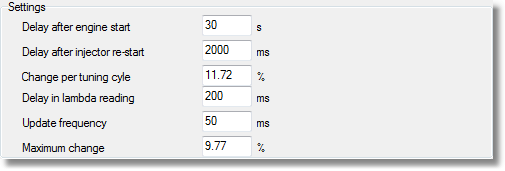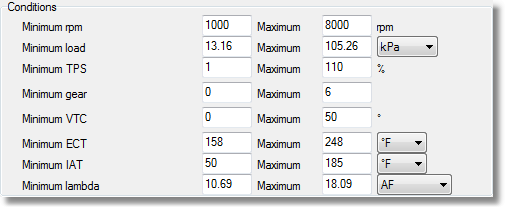Active AFM tuning is where the ECU adjusts the air flow meter table in real time as you drive. It does this within the ECU, so that an external laptop is not required. The AFM table is automatically updated, and can also be downloaded from the ECU.
Operation
The ECU uses target lambda tables and the wideband oxygen sensor lambda to alters values in a air flow meter table. The process is continuous and repetitive so that over time the AFM calibration should result in lower fuel trims..
Parameters
Active fuel tuning
Enables active fuel tuning.

Update Active Tuning Table - this will download the AFT table from the ECU and update the calibration. Note that you must have both saved the calibration after uploading, and either keep the calibration open or re-opened the calibration before downloading the Active Tuning table from the ECU.
Options
These options control when active tuning is operational, and what target lambda is used.

Closed loop - active fuel tuning is operational in closed loop.
Open loop - active fuel tuning is operational in open loop.
Use fuel trims - when in closed loop uses the current fuel trims to better determine the underlying fuel table values.
Target Lambda - selects what lambda the active tuning process should target. In closed loop it is best to use same target as the ECU calculated target lambda (AFMCD). In open loop even though the ECU calculates a target lambda, it is possible to use a target lambda table to give finer control over the lambda target.
Settings
These settings control how active tuning works.

Delay after engine start - in order to allow the oxygen sensor to warm up and after start fuelling to finish, an after start time delay is used so that active fuel timing is disabled after the engine has been started.
Delay after injector re-start - the oxygen sensor will not recorded lambda accurately for a small amount of time after the injectors re-start, which can be set here. The time delay is used when the injectors have shut down due to overrun, but also from the TPS being out of range or the cam angle being out of range under conditions.
Change per tuning cycle - adjustment of the active fuel table value to the calculated value per tuning cycle. Default = 2%. A larger value will adjust the fuel tables more rapidly but could result in rougher fuel table adjustment values.
Delay in lambda reading - adjusts for the delay between the actual engine lambda and the wideband oxygen sensor reading. 150-250ms is typical. You can measure this by noting how long after the injectors re-start the lambda moves from full lean values.
Update frequency - the active fuel tuning update delay. 25-200ms is typical.
Maximum change - the maximum active fuel tuning table adjustment value from the original fuel table.
Conditions
These conditions determine when active tuning is active.

Minimum and maximum values - active tuning is only operational when the engine conditions are between both the minimum and maximum values.
Using Active AFM Tuning
| 1. | Enable active tuning in the calibration and upload to the ECU. |
| 2. | Save the calibration after uploading. |
| 3. | Drive the vehicle for some time period. |
| 4. | Optional. Changes can be incorporated into the main fuel tables by using the 'Update Active Tuning Table' button. |
Notes
| • | If target lambda tables are used, note that they are not the same as WOT compensation tables. |
| • | Live tuning for the AFM table needs to be enabled (it should by default) but fuel tables do not need live tuning. |
| • | Active tuning table adjustment values will be reset if the battery is disconnected. |